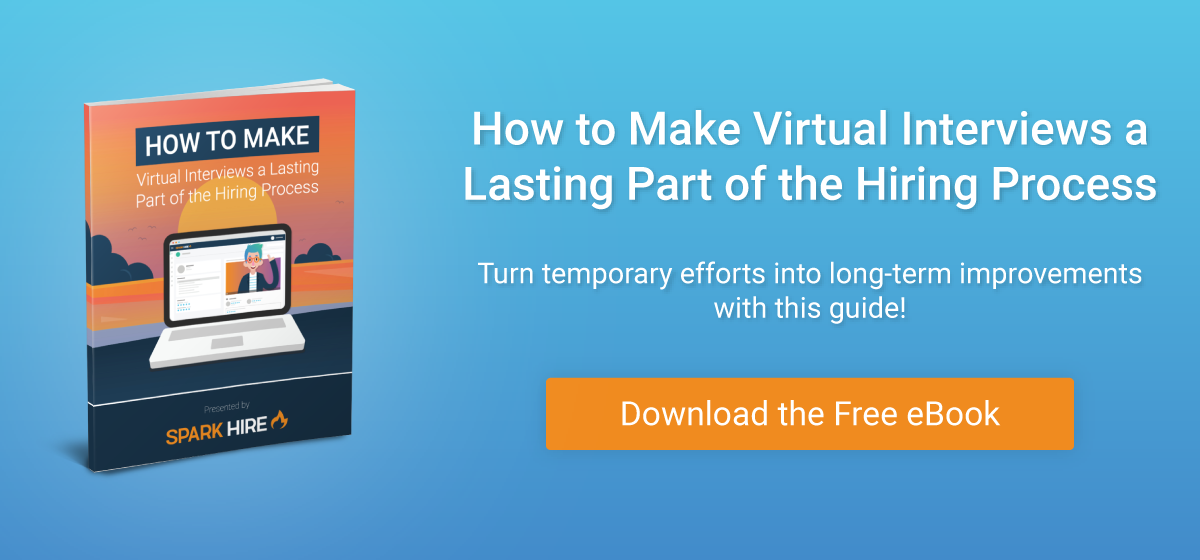As we reach the end of 2020, many companies have decided to continue with remote work long-term. The virtual workplace creates efficiencies in the hiring process, enables worker flexibility, and introduces employers to many more benefits.
We’ve experienced a long year of figuring out what works and what doesn’t when it comes to remote recruiting through talent management. Many leaders and employees see remote work more favorably than just a year ago. Others realize virtual work is not the right fit.
We asked several hiring leaders to weigh in on the changes they’ve experienced since pivoting to remote work this year. They shared how they’ve improved their processes using video interview platforms and other virtual tools.
Here are some firsthand accounts from employers and hiring experts on their experience pivoting to remote work:
Finding talent
From identifying qualified job seekers to communicating with candidates, there are plenty of ways leaders have improved recruitment since going virtual. Not to mention, remote positions allow hiring teams to cast a wider net for their candidate pool.
“We’ve tapped into the power of AI-driven interview tools such as chatbots and talent acquisition platforms that can greatly automate the application process,” says Jagoda Wieczorek, HR Manager at ResumeLab. “On top of that, we now take advantage of smart texting tools, which help us do scaled outreach to prospective candidates and facilitate communications throughout the recruitment process.”
However, with more remote work also comes a broader talent pool. “While it might seem like a good thing at first, it also means you’ll have to rip through a massive number of applications before you can find some real gold,” says Wieczorek.
That’s where intuitive recruitment tools come in handy. With an influx of job applicants, platforms designed for virtual recruitment and hiring make the jobs of HR and hiring leaders easier.
Video Interviews
One of the most significant features personalizing remote hiring is the video interview. Many companies have been conducting interviews this way for years. Those who were just introduced during 2020 company shut-downs are discovering all of the ways video interviews can improve the process.
“Candidates can sit for the interview from their homes, negating the need for travel,” says Mark Hayes, Head of Marketing at Kintell. “I’m also able to interview a greater number of candidates, meaning that turnaround time is quicker for everybody involved.”
Video interview platforms allow hiring pros to schedule more interviews than would be possible in-person. But they also create opportunities for hiring leaders to get creative.
“We’ve started toying with video to introduce candidates to a role. For example, if we’re hiring for a marketer, our current lead marketer would make a video of their day-to-day. Then, we’d send that video to the candidate,” says Quincy Smith, Co-Founder at Test Prep Nerds. “They have served as a good way to introduce a candidate to what they can expect should they get the job.”
Plus, the very nature of adapting to video interviewing can tell you a lot about a candidate.
“Digging into how employees are handling this strange new world ends up giving me a lot of insight into how they’ll approach their role at my company,” says Chris Laan, Founder at Designer Sheds.
Laan also stated video interview platforms make it easier to have the candidate or interviewer share a presentation. “In person, you both have to scrunch together to look at the laptop or set up a projector, but in videoconferencing, presentations are seamless,” he says.
One of the challenges that comes with video interviewing is it takes some getting used to. Sometimes it’s hard for interviewers to get a sense of a candidate’s fit through this format.
“You’re definitely more likely to hire a person who doesn’t fit into the company culture, so there’s a learning curve to identifying these qualities in candidates,” says Nelson Sherwin, Manager at PEO Companies.
But despite the concerns, using video interview platforms can open up a whole new way of thinking regarding interviews. It might even change your hiring process for the better.
“We’ve developed an initiative-based recruiting approach. We require applicants to identify a problem, pitch a solution, and implement that solution in a sprint,” says Joseph Rutakangwa, Founder & CEO at Rwazi. “This model has significantly reduced onboarding time and costs because the implementation sprint is an almost full-proof assessment.”
Onboarding
If you’ve developed an interview system like Rwazi, your virtual interviews might make onboarding easier. But that’s not the case for every company.
“While [virtual interviewing] didn’t impact the quality of candidates, it impacted the onboarding process significantly,” says Ian Kelly, VP of Operations at NuLeaf Naturals. “We had to accept that the process wouldn’t be perfect and that it is harder to manage knowledge in a work-from-home scenario than when you are able to learn on the job.”
Kelly shared that when his team returned to their offices in June, his new employees felt like they had to go through onboarding all over again to get acquainted with office life. If your company plans to return to the office in 2021, understand that your new hires will need to be brought along on the journey when your company culture shifts.
On the flip side, remote work enables new hires to get on their feet faster in some instances. For example, COO, Founder & Head of Talent at Jump, Marja Verbon shared, “One upside of remote hiring is that our latest hire was able to start, despite not having moved to London yet.”
With relocation no longer a burden on your hiring process, remote employees can get to work right away.
Longevity
So the question remains, what does the future of remote hiring and work look like at your company?
For ResumeLab, the answer is clear. “We strongly believe that remote work isn’t sustainable. It stifles creativity as well as collaboration when done on a company-wide scale,” says Wieczorek.
Although, returning to the office doesn’t mean companies can’t take lessons from remote work with them. “We think offering a more flexible structure that may allow for a more fluid work environment could be a great way to attract and retain talent,” says Jim Pendergast, Senior VP of altLINE Sobanco.
Plenty of other companies, however, plan to remain remote through 2021 and beyond. The efficiencies and cost-savings make it an easy decision.
“The remote model just makes sense for our company, and I see no reason to switch to in-office, considering the added expenses and inconvenience for little to no pay-off,” says Sean Nguyen, Director at Internet Advisor.












